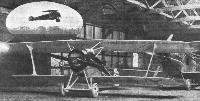
Варианты
- Bleriot-SPAD - S.20 - 1918 - Франция
- Bleriot-SPAD - S.26 - 1919 - Франция
- Bleriot-SPAD - S.27 - 1919 - Франция
Flight, December 1919
SOME FRENCH MACHINES AT THE SHOW
Bleriot and Spad
<...>
Three very interesting Spad machines are exhibited, interesting because, while retaining the characteristics of the Spads built during the War, they are, as regards two of them, designed for sporting purposes, having low-powered engines and consequently reasonable cost and upkeep. The third machine is a three-seater, with the two passengers seated inside an enclosed cabin.
<...>
The third Spad - the three-seater limousine - is a development of the military type S 20, and carries the series number S 27. Like the other two machines shown, it has the general Spad characteristics, although the enclosed body alters its appearance somewhat. The pilot is placed in front, while the two passengers are seated side by side inside the cabin, looking out on the country over which the machine is flying through windows in the "sides of the fuselage. The engine fitted is a 300 h.p. Hispano-Suiza, which gives the machine a maximum speed of 143 m.p.h. The landing speed is about 65 m.p.h. The machine has an overall length of 24 ft., and a span of 32 ft. The weight of the Type S 27 is 1,870 lbs. empty and 2,770 lbs. fully loaded (pilot, two passengers and three hours' fuel).
Описание:
- Flight, December 1919
SOME FRENCH MACHINES AT THE SHOW - Flight, January 1920
The Paris Aero Show 1919
Фотографии
-
Aeroplane Monthly 1983-11 / J.Stroud - Wings of Peace
Регистрационный номер: F-CMAY [2] Spad 27 F-CMAY with four-blade propeller.
-
История Авиации 2002-06 / С.Корж - Коммерческая авиация /Ретроспектива/ (5)
Регистрационный номер: F-CMAV Применялись в первые послевоенные годы в качестве гражданских и штучные аппараты, например, таких переделанных из истребителей сопровождения "Блерио-SPAD-27" было сделано всего три экземпляра, что, учитывая низкую коммерческую отдачу этих машин, в общем, и не удивительно.
-
Flight 1920-01 / Flight
The Spad type S.27, Limousine: Although having an enclosed cabin for the passengers, this machine has retained its streamline monocoque fuselage
-
Flight 1919-12 / Flight
THE SPAD-HERBEMONT, TYPE S. 27, THREE-SEATER MONOCOQUE LIMOUSINE: It is fitted with a 300 h.p. Hispano-Suiza, and has a span of 32 ft., an overall length of 24 ft., and weighs, fully loaded, 2,772 lbs. It has a speed range of 65-143 m.p.h.
-
Flight 1920-03 / Flight
"Spad 27," the Messageries Aeriennes Co.'s 'bus piloted by Lieut. Jean Casale, which brought over mails from Paris on Thursday last week. Inset, Lieut. Casale taking off at Hounslow on Friday for Paris
-
Aeroplane Monthly 1983-11 / J.Stroud - Wings of Peace
Регистрационный номер: F-CMAY [2] LIEUT. JEAN CASALE, THE PILOT OF "SPAD27": This French Ace, during the War brought down 12 machines, gaining the Legion d'Honneur, Medaille Militaire (nine palms), and D.S.O. Lieut. Casale has recently put up three fine records, viz.: height, 9,520 metres (solo); height, 7,300 metres (two passengers); and speed, 288 k.p.h.
Bleriot Spad 27 F-CMAY at Hounslow early in 1920. The minute fin is clearly visible as is the tiny cabin door. -
Flight 1920-10 / Flight
PARIS-LONDON-PARIS RACE: Centre, the Spad, piloted by Bourdon, just landed at Waddon aerodrome. On right, M. Bourdon has his papers signed by M. Rey, the French official, at Croydon. In this picture are Commander H. E. Perrin and Squadron-Leader T. O'B. Hubbard. On the left, M. Bourdon and his two passengers
-
Flight 1920-01 / Flight
SOME SPAD DETAILS: a sketch of the door of the Spad limousine
-
Flight 1920-01 / Flight
SOME SPAD DETAILS: One of the aileron crank levers.
- Фотографии








